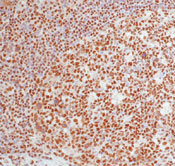NA57 Sigma-AldrichAnti-DNA-PK (Ab-2) Mouse mAb (18-2)
This Anti-DNA-PK (Ab-2) Mouse mAb (18-2) is validated for use in Frozen Sections, Immunoblotting, IF, IP, Neutralization Studies, Paraffin Sections for the detection of DNA-PK (Ab-2).
More>> This Anti-DNA-PK (Ab-2) Mouse mAb (18-2) is validated for use in Frozen Sections, Immunoblotting, IF, IP, Neutralization Studies, Paraffin Sections for the detection of DNA-PK (Ab-2). Less<<Synonyms: Anti-DNA Dependent Protein Kinase
Recommended Products
개요
| Replacement Information |
|---|
주요 사양표
| Species Reactivity | Host | Antibody Type |
|---|---|---|
| H | M | Monoclonal Antibody |
가격 및 재고여부
| 카탈로그 번호 | 재고 정보 | 패킹 | 포장 단위 | 가격(VAT 별도) | 수량 | |
|---|---|---|---|---|---|---|
| NA57-100UGCN |
|
Plastic ampoule | 100 μg |
|
— |
| Product Information | |
|---|---|
| Form | Liquid |
| Formulation | In 10 mM PBS, 0.2% BSA, pH 7.4. |
| Positive control | A-431, HeLa, or HL-60 cells or normal tonsil, normal colon, or breast carcinoma tissue |
| Preservative | ≤0.1% sodium azide |
| Quality Level | MQ100 |
| Physicochemical Information |
|---|
| Dimensions |
|---|
| Materials Information |
|---|
| Toxicological Information |
|---|
| Safety Information according to GHS |
|---|
| Safety Information |
|---|
| Product Usage Statements |
|---|
| Packaging Information |
|---|
| Transport Information |
|---|
| Supplemental Information |
|---|
| Specifications |
|---|
| Global Trade Item Number | |
|---|---|
| 카탈로그 번호 | GTIN |
| NA57-100UGCN | 04055977227598 |
Documentation
Anti-DNA-PK (Ab-2) Mouse mAb (18-2) MSDS
| 타이틀 |
|---|
Anti-DNA-PK (Ab-2) Mouse mAb (18-2) Certificates of Analysis
| Title | Lot Number |
|---|---|
| NA57 |
References
| 참고문헌 보기 |
|---|
| <→EMD:if(output-is PDS)→> Kharbanda, S., et al. 1997. Nature 386, 732. McConnell, K.R., et al. 1997 J. Immunol. 158, 2083-2089. Peterson, S.R., et al. 1997. J. Biol. Chem. 272, 10227. Anderson, C.W. and Carter, T.H. 1996. Curr. Top. Microbiol. Immunol. 217, 91. Blunt, T., et al. 1996. Proc. Natl. Acad. Sci. USA 93, 10285. Carpenter, C.L. and Cantley, L.C. 1996. Curr. Opin. Cell. Biol. 8, 153. Chan, D.W. and Lees-Miller, S.P. 1996. J. Biol. Chem. 271, 8936. Connelly, M.A., et al. 1996. Gene 175, 271. Danska, J.S., et al. 1996. Mol. Cell. Biol. 16, 5507. Han, Z., et al. 1996. J. Biol. Chem. 271, 25035. Lees-Miller, S.P. 1996. Biochem. Cell. Biol. 74, 503. Song, Q., et al. 1996. EMBO J. 15, 3238. Teraoka, H., et al. 1996. FEBS Lett. 393, 1. Blunt, T., et al. 1995. Cell 80, 813. Hartley, K.O., et al. 1995. Cell 82, 849. Kirchgessner, C.U., et al. 1995. Science 267, 1178. Lees-Miller, S.P., et al. 1995. Science 267, 1183. Poltoratsky, V.P., et al. 1995. J. Immunol. 155, 4529. Anderson, C.W. 1993. Trends Biochem. Sci. 18, 433. Gottleib, T.M. and Jackson, S.P. 1993. Cell 72, 131. <→EMD:endif()→> |









 Antibody[223376-ALL].jpg)









